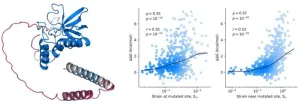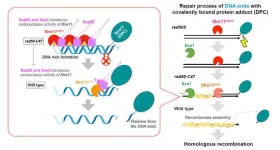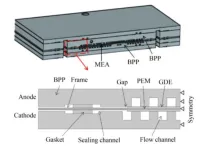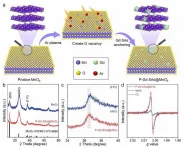(Press-News.org) A new study describing how a prehistoric sea cow was preyed upon by not one, but two different carnivores – a crocodilian and a shark – is revealing clues into both the predation patterns of ancient creatures and the wider food chain millions of years ago.
Published in the peer-reviewed Journal of Vertebrate Paleontology, the findings mark one of the few examples of a creature being preyed upon by different animals during the Early to Middle Miocene epoch (23 million to 11.6 million years ago).
Predation marks in the skull indicate that the dugongine sea cow, belonging to the extinct genus Culebratherium, was first attacked by the ancient crocodile and then scavenged by a tiger shark (Galeocerdo aduncus) in what is now northwestern Venezuela.
“Conspicuous” deep tooth impacts concentrated on the sea cow’s snout, suggest the crocodile first tried to grasp its prey by the snout in an attempt to suffocate it.
Two further large incisions, with a round starting impact, demonstrate the crocodile then dragged the sea cow, followed by tearing it. Marks on the fossils with striations and slashing, indicate the crocodile likely then executed a ‘death roll’ while grasping its prey – a behaviour commonly observed in modern crocodiles.
A tooth of a tiger shark (Galeocerdo aduncus) found in the sea cow’s neck, along with shark bite marks observed throughout the skeleton, show how the remains of the creature was then picked apart by the scavengers.
The team of experts from the University of Zurich, the Natural History Museum of Los Angeles County, as well as Venezuelan institutes Museo Paleontológico de Urumaco and the Universidad Nacional Experimental Francisco de Miranda, state their findings add to evidence that suggests the food chain, millions of years ago, behaved in a similar way to the present day.
“Today, often when we observe a predator in the wild, we find the carcass of prey which demonstrates its function as a food source for other animals too; but fossil records of this are rarer.
“We have been unsure as to which animals would serve this purpose as a food source for multiple predators. Our previous research has identified sperm whales scavenged by several shark species, and this new research highlights the importance of sea cows within the food chain,” explains lead-author Aldo Benites-Palomino, from the Department of Paleontology at Zurich.
While evidence of food chain interactions are not scarce in the fossil record, they are mostly represented by fragmentary fossils exhibiting marks of ambiguous significance. Differentiating between marks of active predation and scavenging events is therefore often challenging.
“Our findings constitute one of the few records documenting multiple predators over a single prey, and as such provide a glimpse of food chain networks in this region during the Miocene.”
The team’s find was made in outcrops of the Early to Middle Miocene Agua Clara Formation, south of the city of Coro, Venezuela.
Among remains, they found a fragmentary skeleton that includes a partial skull and eighteen associated vertebrae.
Describing the dig, co-author Professor of Palaeobiology Marcelo R Sanchez-Villagra explained the discovery as “remarkable” – in particular for where it was uncovered, a site 100 kilometers away from previous fossil finds.
“We first learned about the site through word of mouth from a local farmer who had noticed some unusual “rocks”. Intrigued, we decided to investigate,” says Sanchez-Villagra, who is the Director at the Palaeontological Institute & Museum at Zurich.
“Initially, we were unfamiliar with the site’s geology, and the first fossils we unearthed were parts of skulls. It took us some time to determine what they were—sea cow remains, which are quite peculiar in appearance.
“By consulting geological maps and examining the sediments at the new locality, we were able to determine the age of the rocks in which the fossils were found.
“Excavating the partial skeleton required several visits to the site. We managed to unearth much of the vertebral column, and since these are relatively large animals, we had to remove a significant amount of sediment.
“The region is known for evidence of predation on aquatic mammals, and one factor that enabled us to observe such evidence was the excellent preservation of the fossil’s cortical layer, which is attributed to the fine sediments in which it was embedded.
“After locating the fossil site, our team organized a paleontological rescue operation, employing extraction techniques with full casing protection.
“The operation took about seven hours, with a team of five people working on the fossil. The subsequent preparation took several months, especially the meticulous work of preparing and restoring the cranial elements.”
END
Ancient sea cow attacked by a crocodile and sharks sheds new light on prehistoric food chains
2024-08-29
ELSE PRESS RELEASES FROM THIS DATE:
Georgia Tech neuroscientists explore the intersection of music and memory
2024-08-29
By Jerry Grillo
The soundtrack of this story begins with a vaguely recognizable and pleasant groove. But if I stop writing and just listen for a second, the music reveals itself completely. In Freddie Hubbard’s comfortable, lilting trumpet solo over Herbie Hancock’s melodic, repetitive piano vamping, I recognize “Cantaloupe Island.” Then, with my fingers again poised at the keyboard, Freddie and Herbie fade into the background, followed by other instrumental music: captivating — but not distracting — sonic nutrition, feeding my concentration and productivity.
Somewhere, I think, Yiren Ren is studying, focused on her ...
Waging war on ‘superbugs’ in aged care
2024-08-29
There’s an urgent need for more careful antibiotic management to protect older people living in residential aged care from the dangerous spread of antibiotic resistant bacteria or ‘superbugs’, researchers from Flinders University and SAHMRI warn.
A new study published in the well-respected Journal of Infection, explores the link between the widespread use of antibiotics in residential aged care and the resulting antibiotic resistant bacteria in the gut that can be passed on to other residents.
“Commonly ...
Increasing risk of synthetic opioid drug overdoses in Australia
2024-08-29
A recent study has uncovered alarming insights into the dangers posed by fentanyl-contaminated drug supplies in Australia, including a heightened risk of lethal overdose.
The study, titled ‘The gear could be cut with fentanyl which is starting to happen more in Australia’: Exploring Overdose Survivors’ Perspectives on Toxic Supply and Safe Consumption, aimed to explore the role of synthetic opioids in overdoses among Queenslanders.
Led by Griffith University’s Dr Timothy Piatkowski, Emma Kill and Steph Reeve in partnership with the Queensland ...
Protein mutant stability can be inferred from AI-predicted structures
2024-08-29
Researchers at the Center for Algorithmic and Robotized Synthesis within the Institute for Basic Science have taken a significant step forward in understanding the stability of proteins by leveraging the power of AI. The research team used AlphaFold2 to explore how mutations affect protein stability—a crucial factor in ensuring proteins function correctly and do not cause diseases like Alzheimer's.
DeepMind’s AlphaFold algorithm, which can accurately predict a protein’s structure from ...
Shedding light on the mechanism of yeast DNA repair
2024-08-29
DNA damage is a cellular phenomenon that introduces structural abnormalities in double-stranded DNA. External factors, such as radiation or chemical agents, as well as internal factors, such as blocked DNA replication, can generate double-strand breaks (DSBs) in DNA. To counteract DNA damage, cells engage in DNA repair to preserve genetic integrity and ensure cell survival as failure to repair DSBs has serious health complications like increased risk of cancer.
DSBs are repaired by two mechanisms called non-homologous end joining (NHEJ) and homologous recombination (HR). NHEJ is the predominant DNA repair mechanism in human somatic cells and is ...
Improvement of durability of membrane electrode assembly by frame sealing structure in temperature shock
2024-08-29
Fuel cells offer a promising solution for clean energy with advantages over traditional electric power systems, including extended driving range and higher energy density. Despite these benefits, the high costs and durability concerns associated with fuel cell stacks have limited their commercialization. The durability of membrane electrode assemblies (MEAs), a key component of proton exchange membrane fuel cells (PEMFCs), is particularly affected by the frame sealing structure, which is often overlooked in research.
The study, conducted by Tiankuo Chu ...
Rare earth single atoms enhance manganese oxide's electrochemical oxygen evolution
2024-08-29
An international group of researchers has developed a novel approach that enhances the efficiency of the oxygen evolution reaction (OER), a key process in renewable energy technologies. By introducing rare earth single atoms into manganese oxide (MnO2), the group successfully modulated oxygen electronic states, leading to unprecedented improvements in OER performance.
Their findings were published in the journal Nano Energy on June 10, 2024.
Transition-metal-based oxides have been widely explored for their potential as active OER catalysts. However, the capacity of these catalysts is hindered by the adsorbate evolution mechanism, which ...
Gria: An efficient deterministic concurrency control protocol
2024-08-29
The concurrency control in deterministic databases, i.e., deterministic concurrency control, ensures that each transaction batch produces a unique result. In this way, replicas can process transactions in batches without communicating with each other to ensure consistency, which is simpler and more efficient than non-deterministic databases in achieving high availability through replication.
Early deterministic concurrency control protocols, e.g. Calvin, Bohm, PWV, rely on the prior knowledge of the read-write set, which is impractical in most scenarios. The state-of-the-art Ari breaks this limitation. However, Aria has three issues. First, ...
NSF grants $22 million for 'extreme microbe' lab collaboration
2024-08-29
The National Science Foundation has announced a $22 million grant to establish a “BioFoundry” laboratory for the study of extreme microorganisms with collaborating facilities at UC Riverside, UC Santa Barbara, and Cal Poly Pomona.
The BioFoundry for Extreme and Exceptional Fungi, Archaea, and Bacteria, or ExFAB, will focus on developing techniques to learn from nature’s more unusual microorganisms. These microbes are considered “extreme” because they have unusual nutritional requirements, grow at extremely high or low temperatures, or grow without ...
UC Santa Barbara to lead $22M NSF-funded center on exceptional microbes
2024-08-29
(Santa Barbara, Calif.) — This week, the National Science Foundation announced the award of a six-year, $22M grant to UC Santa Barbara under its biofoundries program for the establishment of the BioFoundry for Extreme and Exceptional Fungi, Archaea and Bacteria (ExFAB), a collaboration led by UC Santa Barbara (UCSB), together with UC Riverside (UCR), and Cal Poly Pomona (CPP). ExFAB establishes the nation’s first biofoundry that focuses on largely untapped and unexplored extreme microbes. UCSB's award is one of only five grants made under NSF's BioFoundry program during this funding cycle, which awarded ...







